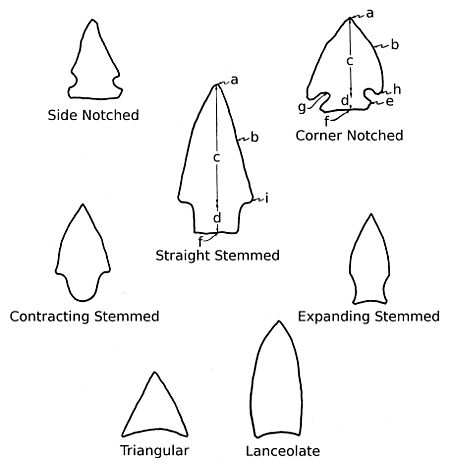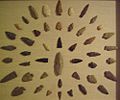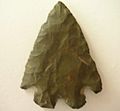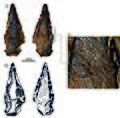Projectile point facts for kids
A projectile point is a sharp object attached to a weapon that could be thrown. Think of it as the tip of a javelin, dart, or arrow. These points are different from tools held in the hand, like knives or spears.
Archaeologists find many stone projectile points because they last a long time. These points give us important clues about people in the past, including how they traded goods. The way a point was made can even tell us about the ancient culture that created it. Scientists can also figure out where the rocks used to make these tools came from.
Besides stone, projectile points were also made from wood, bone, antler, horn, or ivory. In places where people learned to work with metals, points were later made from copper, bronze, or iron. In North America, some old points were even made from copper found near Lake Superior.
Contents
Ancient Points in North America
Many different kinds of ancient arrowheads, dart points, and spear points have been found. People in North America often used rocks like chert, obsidian, quartzite, and quartz to make these points.
For a long time, people thought the oldest points in North America were about 13,000 years old. These were from the Paleo-Indian period, a very early time when people first lived on the continent. However, new discoveries suggest some North American projectile points might be as old as 15,500 years! Some famous Paleo-Indian types include the Clovis, Folsom, and Dalton points.
Different Kinds of Points
Projectile points usually fit into two main groups: points for darts, javelins, or spears, and points for arrows.
Larger points were used for bigger weapons like spears or javelins thrown with a tool called an atlatl. Arrow points are smaller and lighter. They were made to tip arrows shot from a bow.
It can be tricky to tell if a point was used for an arrow or a larger weapon. Some experts look at how wide the part that attaches to the shaft (the hafting area) is. Others think the best way is to look at the point's overall size, weight, length, and thickness. Arrow points are always smaller.
Projectile points come in many amazing shapes and styles. These different styles can tell us about the time period they were made, the culture that made them, and what they were used for.
Common North American Types
Here are some examples of different projectile points found in North America:
- Bare Island projectile point
- Barnes projectile point
- Cascade point
- Clovis point
- Cumberland point
- Eden point
- Elko point
- Folsom point
- Greene projectile point
- Jack's Reef pentagonal projectile point
- Lamoka projectile point
- Levanna projectile point
- Neville projectile point
- Susquehanna broad projectile point
- Plano point
Gallery
-
Ancient Native American projectile points from York County, Pennsylvania.
-
A Thonotosassa type point found in Lorida, Florida.
See also
 In Spanish: Punta lítica para niños
In Spanish: Punta lítica para niños










